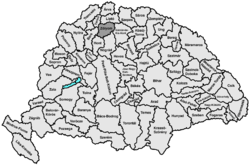Zvolen county
| Zólyom County Comitatus Zoliensis (Latin) Zólyom vármegye (Hungarian) Komitat Sohl (German) Zvolenská župa (Slovak) |
|||||
| County of the Kingdom of Hungary | |||||
|
|||||
|
Coat of arms |
|||||
| Capital |
Besztercebánya 48°44′N 19°9′E / 48.733°N 19.150°ECoordinates: 48°44′N 19°9′E / 48.733°N 19.150°E |
||||
| History | |||||
| • | Established | 12th century | |||
| • | Treaty of Trianon | 4 June 1920 | |||
| Area | |||||
| • | 1910 | 2,634 km2(1,017 sq mi) | |||
| Population | |||||
| • | 1910 | 133,653 | |||
| Density | 50.7 /km2 (131.4 /sq mi) | ||||
| Today part of | Slovakia | ||||
| Banská Bystrica is the current name of the capital. | |||||
Coat of arms
Zólyom county (in Latin: comitatus Zoliensis, in Hungarian Zólyom (vár)megye, in Slovak Zvolenský komitát/ Zvolenská stolica/ Zvolenská župa, in German Sohler Gespanschaft/Komitat Sohl) was an administrative county (comitatus) of the Kingdom of Hungary. Its territory is now in central Slovakia.
Zólyom county shared borders with the counties of Bars, Turóc, Liptó, Gömör-Kishont, Nógrád and Hont. The county's territory was situated along the central Garam river, approximately between (excluding) Korpona and (including) Breznóbánya. Its area was 2634 km² around 1910. The county was characterised by extensive mining activities.
The capital of the county was the castle of Pusztavár near Zólyom, then from the late 15th century the Zvolen Castle (Hungarian: Zólyomi vár) and from the 1760s the town of Besztercebánya.
Zólyom county arose as a Hungarian comitatus in the 12th century, when most parts of the territory were conquered by the Kingdom of Hungary, from a huge royal property (the Vetusolium dominium). Initially, its territory included Árva, Turóc and Liptó, which became separate counties in the early 14th century.
...
Wikipedia


